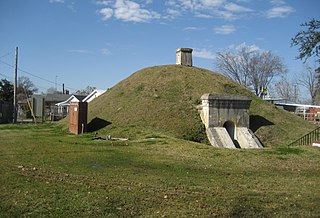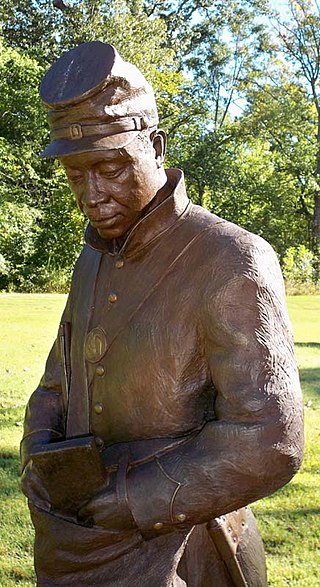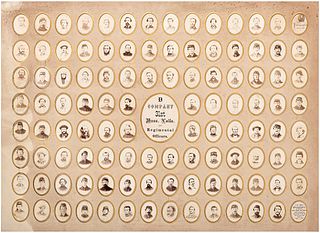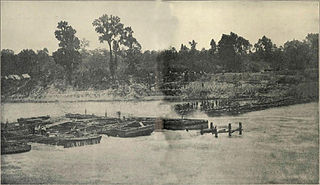
United States Colored Troops (USCT) were Union Army regiments during the American Civil War that primarily comprised African Americans, with soldiers from other ethnic groups also serving in USCT units. Established in response to a demand for more units from Union Army commanders, by the end of the war in 1865 USCT regiments, which numbered 175 in total, constituted about one-tenth of the manpower of the army. Approximately 20 percent of USCT soldiers were killed in action or died of disease and other causes, a rate about 35 percent higher than that of white Union troops. Numerous USCT soldiers fought with distinction, with 16 receiving the Medal of Honor. The USCT regiments were precursors to the Buffalo Soldier units which fought in the American Indian Wars.

The 3rd Illinois Cavalry Regiment was a cavalry regiment that served in the Union Army during the American Civil War. It fought at such battles as Pea Ridge, Sherman's Yazoo campaign, the battle of Port Gibson, and the siege of Vicksburg.

The 128th New York Infantry Regiment, nicknamed Old Steady, was a volunteer regiment from Dutchess County and Columbia County in upstate New York, during the American Civil War. Formed in Hudson, New York, on September 5, 1862, by Col. David S. Cowles, the regiment was made up of volunteers from the surrounding towns and villages.
The Battle of Stirling's Plantation was an American Civil War battle took place on September 29, 1863 in Pointe Coupee Parish, Louisiana.

The 12th Maine Infantry Regiment was an infantry regiment that served in the Union Army during the American Civil War.

Camp Parapet was a Civil War fortification at Shrewsbury, Jefferson Parish, Louisiana, a bit more than a mile upriver from the current city limits of New Orleans.
The 3rd Louisiana Regiment Native Guard Infantry was a regiment in the Union Army during the American Civil War.

The 2nd Rhode Island Cavalry Regiment was a cavalry regiment of the Union Army in the American Civil War.
The 11th United States Colored Heavy Artillery Regiment, previously designated the 14th Rhode Island Heavy Artillery Regiment (Colored), was an African American artillery regiment that served in the Union Army during the American Civil War.

The 118th Illinois Volunteer Infantry was an infantry regiment in the Union Army during the American Civil War. On June 10, 1863, the regiment was converted to mounted infantry.

The 1st Louisiana Native Guard was one of the first all-black regiments in the Union Army. Based in New Orleans, Louisiana, it played a prominent role in the Siege of Port Hudson. Its members included a minority of free men of color from New Orleans; most were African-American former slaves who had escaped to join the Union cause and gain freedom. A Confederate regiment by the same name served in the Louisiana militia made up entirely of free men of color.

The 55th United States Colored Infantry Regiment was a United States Colored Troops infantry regiment in the Union Army during the American Civil War. It was first organized as the 1st Alabama Volunteer Infantry Regiment (African Descent) in May 1863, serving on garrison duty at Corinth, Mississippi and Memphis, Tennessee. It was redesignated as the 55th United States Colored Infantry in March 1864, continuing its garrison service in Tennessee and fighting at the Battle of Brices Cross Roads. After the end of the war, the regiment was mustered out in late 1865 after garrison duty in Louisiana.
The 12th Connecticut Infantry Regiment was an infantry regiment that served in the Union Army during the American Civil War.

The 13th Connecticut Infantry Regiment was an infantry regiment that served in the Union Army during the American Civil War.

The 75th New York Infantry Regiment was an infantry and mounted infantry regiment in the Union Army during the American Civil War.

The 31st Massachusetts was an infantry regiment that served in the Union Army during the American Civil War. It was converted into a mounted infantry regiment in December 1863.
The 3rd Massachusetts Volunteer Cavalry Regiment was a cavalry regiment that served in the Union Army during the American Civil War. It was organized by consolidating the 41st Massachusetts Mounted Infantry and the 2nd Battalion Massachusetts Cavalry on June 17, 1863. The regiment served with the XIX Corps, Army of the Gulf during the Red River Campaign in 1864. Its heaviest combat during this campaign took place during the Battle of Sabine Crossroads.

The 13th Texas Cavalry Regiment was a unit of mounted volunteers recruited in Texas that fought in the Confederate States Army during the American Civil War. The regiment was enrolled in Confederate service in February 1862 and served exclusively west of the Mississippi River. The unit was later dismounted and became part of the Texas infantry division known as Walker's Greyhounds. The regiment fought at Milliken's Bend in 1863 and Mansfield, Pleasant Hill, and Jenkins' Ferry in 1864. The regiment disbanded in May 1865, but its official surrender date was 2 June 1865.

The 4th Louisiana Infantry Regiment was a unit of volunteers recruited in Louisiana that fought in the Confederate States Army during the American Civil War. Formed in May 1861, the regiment served in the Western Theater of the American Civil War. The unit fought at Shiloh and Baton Rouge in 1862 and at Jackson in 1863. A detachment served during the Siege of Port Hudson and was captured. In 1864, the regiment fought in the Atlanta campaign where it lost heavily at Jonesborough. At Nashville in December 1864 most of the men were captured. The survivors were consolidated with several other units and fought at Spanish Fort in April 1865. The remnant surrendered in May 1865.

The 97th United States Colored Infantry was an engineer regiment designated as infantry as part of the United States Colored Troops that served in the Union Army during the American Civil War and fought in the Western Theater of the American Civil War in the Department of the Gulf. The regiment mustered in at Camp Parapet April 28, 1863, as the 1st Louisiana Engineers, but two companies, D and F had been hastily mustered into service two days earlier, April 26, 1863, and sent to Berwick City to remove obstructions from the Bayou Teche. The enlisted men of the 1st Louisiana Engineers were formerly enslaved men in the “engineer camp” who had been previously providing labor for the U.S. Army between New Orleans and Baton Rouge. Several of the newly commissioned company grade officers had been enlisted men of the 42nd Massachusetts Volunteer Infantry who had been on engineer service superintending the contraband laborers from the camp. In the summer of 1862, General Phelps had previously requested to arm the men at Camp Parapet and put them in uniform to defend the city of New Orleans but his request was denied. Gen. Banks ordered Phelps to have the men cut down all the trees between Camp Parapet and Lake Pontchartrain. Phelps resigned over the issue stating, "...while I am willing to prepare African regiments for the defense of the government," he continued, that he " was not willing to become a mere slave driver."
















